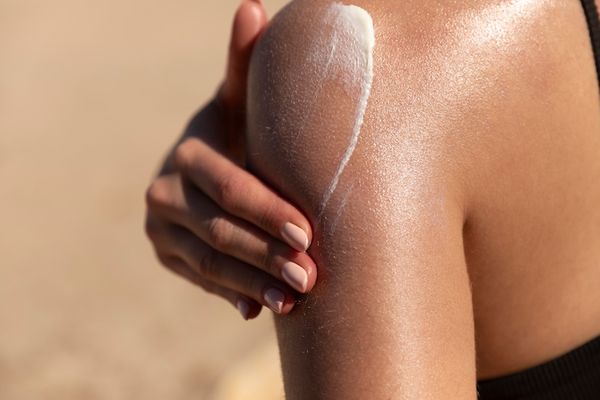With increased awareness surrounding the consequences of excessive sun exposure, more people are recognizing the benefits of sunscreen and working to incorporate it into their regular skin care routines. Failing to protect your skin from undue amounts of UV radiation can cause early, more rapid signs of aging and skin damage that can lead to skin cancer.
With or without makeup, sunscreen is a vital part of caring for your skin.
But just like with other skin care products, choosing the right sunscreen can seem overwhelming. There are so many choices, formulations and levels of protection that knowing which one to grab off the shelf can get confusing.
It helps to know how sunscreens work and what the claims on the labels actually mean.
There are two types of sunscreen: chemical and mineral, also called physical.
Chemical sunscreens contain compounds that absorb UV light and turn it to heat before it can penetrate the skin. Because they also themselves absorb into the epidermis, there has been much controversy of late regarding the safety of some of the chemicals most commonly used in traditional formulations. Recent research has shown that avobenzone, in particular, shows up in blood and urine tests taken after use. It is also a known allergen that can cause reactions on sensitive skin.
Mineral or physical sunscreens do not absorb into the skin, but instead form a physical barrier on top of the skin that both absorbs some UV rays and scatters others away. When first becoming popular as a cleaner alternative to sun protection, formulations were thick and sticky and resulted in a white cast to the skin. As clean cosmetics and skin care products have advanced, more recent iterations have proven much creamier and more elegant in application, with many mineral sunscreens offering transparent coverage.
Both types of sunscreens are effective at protecting the skin, so it comes down to a matter of personal preference with texture, fragrance and earth and body friendliness.
In the United States, unlike in European countries, sunscreen is considered a drug (instead of a cosmetic) and regulated by the FDA, which means it must have an ingredient label. Here’s where things can get confusing.
Active vs. Inactive Ingredients
The FDA allows up to 12 additives in chemical formulas, but only two for their mineral counterparts (titanium dioxide and zinc oxide.) Anything designed to protect you from the sun will be listed as an active ingredient. Inactive ingredients include those with other benefits or functions. These can be things like product stabilizers and fragrances, as well as yummy skin-loving ingredients like antioxidants to fight skin-aging free radicals from the sun’s rays and niacinamide to boost collagen and improve skin tone.
SPF
The sun protection factor, or SPF, is a guide for how long it may take the skin to burn with sun exposure. If a product has an SPF of 30, it will take roughly 30 times longer for an individual’s skin to burn than without protection. This is particular to each person who wears it as some people simply burn more easily than others.
Broadspectrum
Think of UVA rays as those that “accelerate aging” and UVB rays as those that “burn.” You need protection from both, and this is what a broadspectrum sunscreen provides. If this word is not on the label, you may only have protection from one or the other.
Important Miscellaneous Claims
Sunscreen bottles make lots of claims aside from their SPF, and some may matter more to you than others. In general, mineral sunscreens are more likely to meet the following criteria.
Cruelty free — not tested on animals
Reef friendly — safe for humans, as well as marine life such as the coral reef
Hypoallergenic — less likely than others to cause an allergic reaction
Dermatologically tested — a dermatological professional has overseen all testing and tolerance tests
Sunscreens offer a variety of skin-protecting benefits, and many of them can actually improve and reverse certain previous sun damage, however none will work if not applied properly or reapplied often enough.
Experts advise the equivalent of a half of a teaspoon for the face and neck, and a shot glass full for the rest of the body. Sunscreens should be rubbed onto the skin (even if sprayed) to ensure adequate coverage. Don’t forget often neglected areas like the tips of your ears, the back of your neck, the back of your hands and the tops of your feet!
Because chemical sunscreens must be absorbed into the skin to be effective, they should be applied 15-30 minutes before sun exposure. Mineral sunscreens offer immediate protection.
Swimming and sweating often mean you should reapply your sunscreen every two hours or so, but so does scratching or rubbing your face or arms and the friction from clothing or towels. Even your skin’s own natural oil production can dilute a sunscreen and compromise its effectiveness.
Kalologie MedSpa Austin offers an extensive line of skin care and sun protection products featuring transparent, mineral-based formulations that firm, hydrate and protect your skin. In a variety of SPFs, with and without tint, our products include dermatologically tested, medical grade ingredients for every skin type.
Our aestheticians and friendly staff are happy to discuss the many benefits of wearing sunscreen regularly and which products may be right for you.

